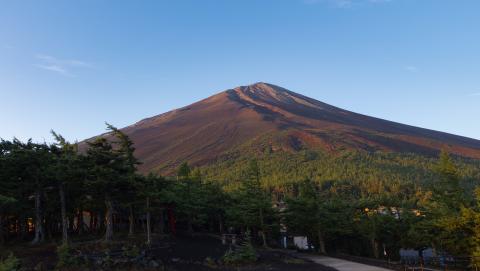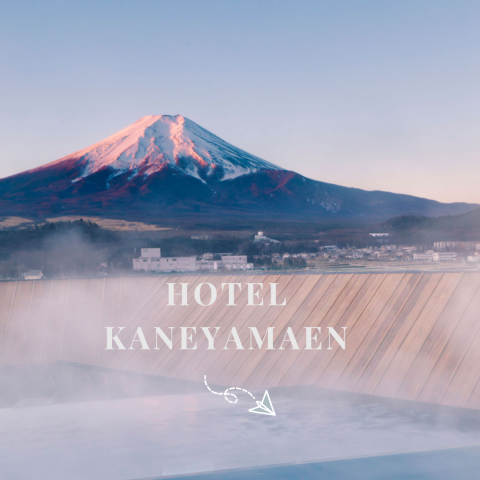Main content starts here.
Minobu is located in south-western Yamanashi, and is one of the lesser-known areas of the prefecture. Today, we are going to introduce some of its top travel spots.
Kuonji Temple

▲Kuonji Temple in Minobu
Kuonji Temple on Mt. Minobu is the main temple of the "Nichiren" sect of Buddhism. At a time when the Japanese people were struggling through plagues and natural disasters, Buddhist priest, Nichiren, created the Lotus Sutra and began his missionary activities. Unfortunately, Nichiren, having ideals that went against the interests of the Shogunate, was sentenced to exile three times and was left on an island abandoned to his own fate. However, after returning alive from his exile death sentence, Nichiren was invited by Nanbu Sanega, descendant of Kai Genji to be part of Minobusan Kuonji Temple. After the invitation, he remained for nine years in those mountains, reciting the Lotus Sutra and dedicating to the education of his disciples.
Nichiren spent the last years of his life on Mt. Minobu. However, because of a need for medical treatment and a desire to visit his parents' tomb, he left Mt. Minobu for "Hitachi no Kuni" (present-day Ibaraki Prefecture), but died at the age of 61 in Musashi (present-day Tokyo). In his will, he expressed his wish to have his tomb built on Mt. Minobu. Thus, Mt. Minobu became home to the Nichiren sect of Buddhism. More than 700 years have passed since Nichiren's death, but his lessons are kept alive by his disciples, generation after generation.
Kuonji Temple on Mt. Minobu attracts visitors from all over Japan, and it is also home to a 400-year old cherry tree.

▲Main entrance to the temple, followed by a staircase



"Bodaitei" refers to the stone staircase leading to the temple. It is 287 steps and 104 meters long. The number of steps was chosen in reference to the main mantra of this stream of Buddhism (Nam Myōhō Renge Kyō), which when written in Japanese, is composed of 7 characters, and because it must be sung 41 times, it adds up to 287 Japanese characters. According to tradition, the ascent done while reciting the mantra symbolizes the passage through life's challenges.

▲View from the top of the staircase
We did it! We climbed the entire staircase! The air felt a little different up here. It is said that climbing these stairs carries about half of the importance of the entire pilgrimage!


Just after the staircase on the left side is the famous 5-story pagoda of Kuonji. Partially destroyed by a major fire in the Meiji Era, the pavement was rebuilt and reopened in 2008 and is now hailed as the 4th tallest pagoda in all of Japan.




These photos were taken in July after the rainy season. The lotus flower, known as the symbol of Buddhism, was in full bloom.


▲Inside the main temple
Immediately after the main entrance, the image on the ceiling caught our attention: a 9m² gold dragon. According to our guide, this 5-claw dragon represents the highest class of dragons. The image was designed in such a way that looking at the design from inside the temple, regardless of where you stand, gives the impression of being watched over by the dragon. According to Buddhist tradition, the dragon named “Ryuju” is always watching over us.
*Photography is prohibited inside the temple.


During our stay, we also learned about the hierarchy between the monks and its correlation with the seating placement during ceremonies. The highest seat in the picture on the left, for example, can only be occupied by the main monk, whose entrance is received with the beat of this large drum, as shown in the image on the right.
The main temple of Kuonji was rebuilt 34 years ago, at the cost of 600 million yen. Its interior has the capacity to accommodate up to 2,500 people during ceremonies, which have been held every morning since its reopening.

There is a strong focus on self-discipline. At Kuonji Temple, every day from 9am to 3pm, the sutra is sung by the younger monks in turns. At the time of our visit, one monk was playing the Mokugyo (a small fish-shaped percussion instrument made of wood, often used in Buddhist temples). According to our guide, the reason the sutra is recited so quickly is so that it can be repeated several times in a short period.

▲Goshin Kotsudou
This is where the remains of Nichiren are stored. Considered the most reserved place in Kuonji Temple, only monks are allowed to enter. Protecting the integrity of Nichiren's remains is one of the highest duties of a monk. This temple was built in such a way that it cannot be seen from the outside. There is also a security system designed to protect Nichiren's remains, which will activate and move the urn to a protected underground compartment in case of an earthquake or fire. The monk who guided us highlighted the fact that Nichiren now remains in an incredible state of preservation, despite the harsh lifestyle he had led during his period of exile.

▲Hand-drawn portrait of Nichiren
This is an enlarged replica of a hand-drawn portrait of Nichiren. According to our guide, his sanctity was such that the artist was not to look at him directly in the eyes. Therefore, he had to use Nichiren’s reflection in the water as a reference when he drew him. For this reason, the work was named “Mizu Kagami no Miei” (reflection in the water mirror).


Every day at 5:00am and 4:55pm, the big temple bell is rung. Its sound can be heard within a 1-kilometer radius. In order to move the log to ring the bell, young monks must use the weight of their entire body, as seen in the image above.
“Shukubo” Stay (Temple Lodge): Kishinobo


▲Exterior view of Kishinobo
At Mt. Minobu, you can also experience a traditional, monk-style stay at "Kishinobo." This accomodation is located in the vicinity of Nichiren's house, near his grave.


The rooms were very spacious, with large windows, giving a view of the surrounding, lush nature. If you open the windows, you can enjoy the sound of the surrounding lakes and waterfalls.


▲Dinner time
The meal consisted of vegetables straight from local farms, as well as the famous side dishes that fit perfectly with Japanese food, such as “Yuba,” a tofu-based dish and Minobu specialty. A monk's meal does not contain meat, but the hotel offers meat dishes as well to please its guests.
Early Morning Prayer




The next morning, we woke up at 5am and attended the morning prayer in the temple. This ceremony is held every morning, every day of the year. Mt. Minobu is known as a holy place for prayer. During our visit to the mountain, we were able to observe the devotion and respect for the Buddhist traditions.


Mountain Yoga


We also participated in yoga at 7:30am, in the main temple lobby.
*To participate you must register in advance.
Contact 0556-62-1011 (Minobusan Kuonji Missionaries Department)


▲Breakfast served after the morning prayer and yoga
Nichiren's Tomb and Gosoan-ato




▲Gobyosho (tomb)
Here lies the tomb of Nichiren, who expressed his desire to be buried in Minobu in his will.


▲Gosoan-ato
To the right of Nichiren's tomb, there a preserved area which was the actual location of the house where he spent his nine years on the mountain.
Treasure Hall and Sutra Workshop
In the basement of the main temple, there is a "Treasure Hall" that houses more than 700 years of history through statues, manuscripts and other objects considered a part of the national heritage.
*Photography is prohibited. To see the exhibit, you must attend in person.




You can try the Treasure Hall's sutra-copying workshop, as it is included in your admission. Using traditional Japanese ink and a brush, each visitor can copy a sutra of their choice. There is a small pamphlet with explanations (in Japanese) about the meaning of the verses.
Mt. Minobu Ropeway




▲Mt. Minobu Ropeway
Behind the Kuonji Temple is a ropeway leading to the top of Mt. Minobu (7-minute ride). This area is full of shops, great views, treats, and an important temple known as "Okunoin Shishinkaku."

▲Diamond Fuji
Okunoin Shishinkaku Temple
The top of Mt. Minobu is thought to be overflowing with positive, mystical energy. In late March and once again in late September, you can see the phenomenon known as "Diamond Fuji," which occurs when the sun rises to align exactly with the top of Mt. Fuji.


▲Okunoin Shishinkaku Temple
At the top of Mt. Minobu, there is the Okunoin Shishinkaku Temple. Every day that Nichiren was living on Mt. Minobu, he would climb the mountain and visit this temple to pay his respects to his deceased parents and former Buddhist master, who were buried far off in his home of Minami-Bousou (modern day Chiba Prefecture). As Nichiren was fiercely chased off by the Bakufu Government, and had saught asylum in Minobu, he was unable to be by his parents and masters side when they died. Because of this, he felt that he had failed at his filial piety duties.
Inspired by the deep feelings he held towards his parents and his master, who was like a spiritual father to him, this area where he went to pay his respects was coined, the "Summit of Familiar Love." And the temple where he often visited, took the name "Shishinkaku," meaning, "Temple of Parental Remembrance."


▲Cedar trees on the temple grounds
On the temple grounds, there are four cedar trees, planted by Nichiren himself. He planted them in honor of his father, his mother, the doctor who accompanied him during his life on the hill, and the nation of Japan.

Inside the temple, there is a sign reading, "Chionhouon," or "to be conscious of kindness and know to pay it forward." According to this philosophy, it is important to return the favors we receive.


On the mountain, the weather changes very quickly. When we visited the temple a sudden haze washed over the scenery as we walked along "Hinoji no Mori Mountain.".


▲Delicious dango dumplings for sale
Also, don't forget to try some of the delicious dango dumplings for sale at the top of the mountain.
More Info
Minobu Tourism website:
https://www.town.minobu.lg.jp/kanko/
Kuonji Temple website:
https://www.kuonji.jp/
Kishinobo (Temple Lodging):
https://www.yamanashi-kankou.jp/kankou/stay/n4_8106.html
Published on
- April 14, 2022
Share
-

Fuji Subaru Line 5th Station & Mt. Fuji Travel Guide
March 3, 2025
Home of Mt. Fuji > Staff Journal > Things to Do in Minobu

